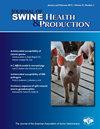Evaluation of a staged loadout procedure for market swine to prevent transfer of pathogen contaminated particles from livestock trailers to the barn
IF 0.7
4区 农林科学
Q3 Agricultural and Biological Sciences
引用次数: 3
Abstract
Objective: Evaluate the effectiveness of a staged market pig loading procedure for reducing contaminant transfer from livestock trailers to the barn. Materials and methods: A conventional loading procedure was compared to a staged procedure, with 10 replicates each. In the staged procedure, one loadout crew member was stationed between two lines of separation and could not cross onto the livestock trailer or into the center alleyway of the barn. The remaining loadout crew members within the barn could not cross into the loadout alleyway or chute. In the conventional procedure, a loadout crew member moved pigs from the center alleyway, through the loadout alleyway, and up the chute, but did not cross onto the livestock trailer. Fluorescent powder was mixed with obstetrical lubricant and wood shavings and spread evenly on the livestock trailer floor, just inside the roll-up door that opens to the chute. After each loadout, fluorescent powder contamination was evaluated at 8 locations: one in the chute, two in the loadout alleyway, and five in the center alleyway of the barn. Results: Four of five center alleyway locations had significantly lower contamination (P < .05) for the staged protocol compared to the conventional protocol. The level of contamination at the fifth center alleyway location was not statistically different (P = .057). The contamination level at all other locations was not statistically significant between the two groups (P > .05). Implications: The staged loading procedure effectively reduced the transfer of fluorescent powder from the livestock trailer to the barn.防止病原体污染颗粒从牲畜拖车转移到畜棚的市场猪分阶段装载程序的评估
目的:评估分阶段市场猪装载程序减少污染物从牲畜拖车转移到畜棚的有效性。材料和方法:将常规加载程序与分阶段程序进行比较,每个程序重复10次。在分阶段的程序中,一名装船船员驻扎在两条隔离线之间,无法穿过牲畜拖车或进入谷仓的中央小巷。谷仓内剩下的装船船员无法穿过装船通道或滑道。在传统程序中,一名装船船员将猪从中心小巷移走,穿过装船小巷,然后沿着滑道向上移动,但没有穿过牲畜拖车。荧光粉与产科润滑剂和木屑混合,均匀地撒在牲畜拖车的地板上,就在通向滑槽的卷帘门内。每次装载后,在8个位置评估荧光粉污染:一个在斜槽中,两个在装载小巷中,五个在谷仓的中央小巷中。结果:与传统方案相比,分阶段方案的五个中心小巷位置中有四个位置的污染显著较低(P<0.05)。第五中心小巷位置的污染水平没有统计学差异(P=.057)。两组之间所有其他位置的污染程度没有统计学意义(P>0.05)。提示:分阶段装载程序有效地减少了荧光粉从牲畜拖车转移到谷仓的情况。
本文章由计算机程序翻译,如有差异,请以英文原文为准。
求助全文
约1分钟内获得全文
求助全文
来源期刊
CiteScore
1.80
自引率
0.00%
发文量
29
审稿时长
>36 weeks
期刊介绍:
The Journal of Swine Health & Production (JSHAP) is an open-access and peer-reviewed journal published by the American Association of Swine Veterinarians (AASV) since 1993. The aim of the journal is the timely publication of peer-reviewed papers with a scope that encompasses the many domains of applied swine health and production, including the diagnosis, treatment, management, prevention and eradication of swine diseases, welfare & behavior, nutrition, public health, epidemiology, food safety, biosecurity, pharmaceuticals, antimicrobial use and resistance, reproduction, growth, systems flow, economics, and facility design. The journal provides a platform for researchers, veterinary practitioners, academics, and students to share their work with an international audience. The journal publishes information that contains an applied and practical focus and presents scientific information that is accessible to the busy veterinary practitioner as well as to the research and academic community. Hence, manuscripts with an applied focus are considered for publication, and the journal publishes original research, brief communications, case reports/series, literature reviews, commentaries, diagnostic notes, production tools, and practice tips. All manuscripts submitted to the Journal of Swine Health & Production are peer-reviewed.

 求助内容:
求助内容: 应助结果提醒方式:
应助结果提醒方式:


